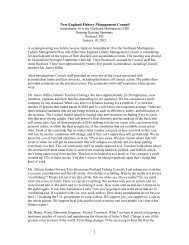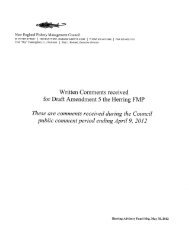Smooth Bottom Net Trawl Fishing Gear Effect on - New England ...
Smooth Bottom Net Trawl Fishing Gear Effect on - New England ...
Smooth Bottom Net Trawl Fishing Gear Effect on - New England ...
You also want an ePaper? Increase the reach of your titles
YUMPU automatically turns print PDFs into web optimized ePapers that Google loves.
NOAA/NMFS Unallied Science Project, Cooperative Agreement NA16FL2264 December 2005<br />
<str<strong>on</strong>g>Smooth</str<strong>on</strong>g> <str<strong>on</strong>g>Bottom</str<strong>on</strong>g> <str<strong>on</strong>g>Net</str<strong>on</strong>g> <str<strong>on</strong>g>Trawl</str<strong>on</strong>g> <str<strong>on</strong>g>Fishing</str<strong>on</strong>g> <str<strong>on</strong>g>Gear</str<strong>on</strong>g> <str<strong>on</strong>g>Effect</str<strong>on</strong>g> <strong>on</strong> the Seabed:<br />
Investigati<strong>on</strong> of Temporal and Cumulative <str<strong>on</strong>g>Effect</str<strong>on</strong>g>s BKAM/CR<br />
3.4.2 Mud Hole Post-<str<strong>on</strong>g>Trawl</str<strong>on</strong>g> Results (October 9 and November 19, 2002)<br />
The first set of post-trawl samples taken from the Mud Hole trawled lanes in early October 2002,<br />
had an average of 61 species and 910 individuals. Spio limicola was the dominant species at<br />
both stati<strong>on</strong>s (MH1B and MH3B) with Pri<strong>on</strong>ospio the next most abundant organism. The<br />
remaining dominant species were predominantly polychaetes such as Dipolydora socialis,<br />
Mediomastus californiensis, Maldane sarsi, Tharyx acutus and Anobothrus gracilis. The small<br />
bivalve Nucula delphinod<strong>on</strong>ta was am<strong>on</strong>g the dominants at the northern stati<strong>on</strong> (MH1B) both<br />
before and after trawling. At the southern stati<strong>on</strong> (MH3B) this species was present but not<br />
abundant for each of the sampling events. All of the other species listed as dominants in the pretrawl<br />
survey were comm<strong>on</strong> or abundant in the post-trawl data. The sec<strong>on</strong>d set of post-trawl<br />
samples taken in November 2002 from the experimentally trawled lanes, averaged 67 species<br />
and 890 individuals. They were not significantly different in number of species and individuals<br />
from either the July pre-trawl or October post-trawl sampling results.<br />
In the c<strong>on</strong>trol lanes, the first post-trawl samples (October) averaged 61 species and 874<br />
individuals. Similar to the trawled lanes, Spio limicola was dominant in all cases except at<br />
MH4B where densities of Spio and Pri<strong>on</strong>ospio were almost the same (685 and 654 individuals,<br />
respectively). Other than the small molluscs, Nucula delphinod<strong>on</strong>ta, Thyasira gouldii, and<br />
Phor<strong>on</strong>is architecta, the remaining species listed am<strong>on</strong>g the most numerous were all<br />
polychaetes. These included Mediomastus californiensis, Tharyx acutus, Aricidea catherinae,<br />
Dipolydora socialis and Anobothrus gracilis. The compositi<strong>on</strong> of the remaining dominant<br />
species was not significantly different from that found at the trawled stati<strong>on</strong>s. The November<br />
post-trawl samples had 64 species and 884 individuals. There were no major changes in faunal<br />
compositi<strong>on</strong>.<br />
3.4.3 Little Tow Baseline Results (July 2002 pre-chr<strong>on</strong>ic trawling)<br />
Species richness and densities at the benthic stati<strong>on</strong>s in Little Tow were similar to those found at<br />
Mud Hole.<br />
Pre-trawl samples at the trawled lanes (LT1B and LT3A) averaged 797 individuals of 63 species.<br />
Pri<strong>on</strong>ospio was the dominant species at LT1B, but Spio was more abundant at LT3A. Other<br />
comp<strong>on</strong>ents of the fauna were similar. Additi<strong>on</strong>al polychaetes included Tharyx acutus,<br />
Anobothrus gracilis and Mediomastus californiensis. N<strong>on</strong>- polychaete species that were<br />
comm<strong>on</strong> were the bivalves, Thyasira gouldii and Nucula delphinod<strong>on</strong>ta. The isopod,<br />
Ptilanthura tenuis was am<strong>on</strong>g the dominants at LT1B, but was present in much reduced numbers<br />
at LT3A. Many of the dominant species were the same as those found at Mud Hole.<br />
The pre-trawl samples at the c<strong>on</strong>trol lane stati<strong>on</strong>s (LT2B and LT4A) had mean densities of 644<br />
organisms per grab and 56 species. Dipolydora socialis was the most abundant species at LT2B<br />
and Pri<strong>on</strong>ospio was the most comm<strong>on</strong> species at LT4A. Six other dominant species were<br />
comm<strong>on</strong> to both c<strong>on</strong>trol lane stati<strong>on</strong>s. There were significant numbers of the tube dwelling<br />
amphipod Unciola inermis in two samples at LT2B but this species was barely represented at<br />
Stati<strong>on</strong> LT4A (4 individuals).<br />
44







